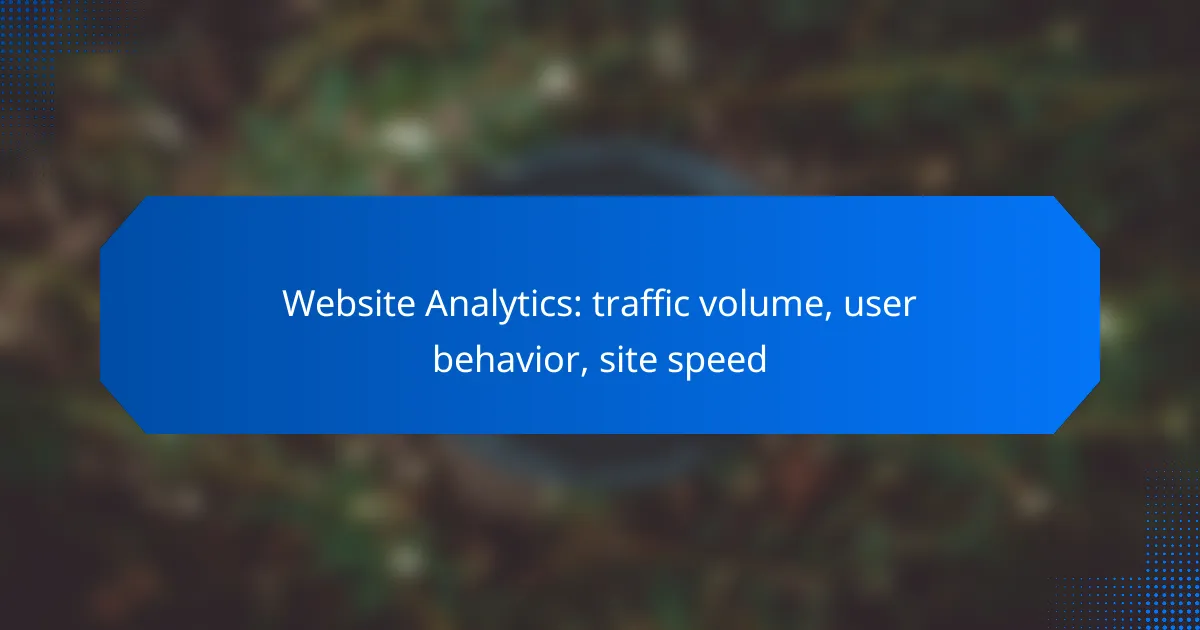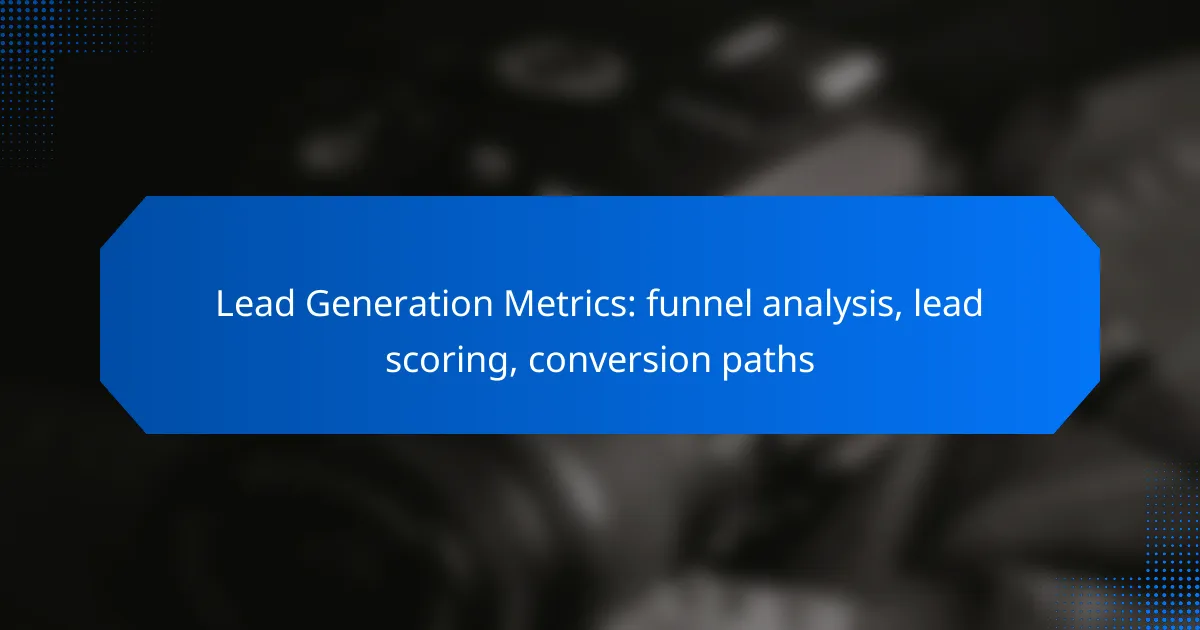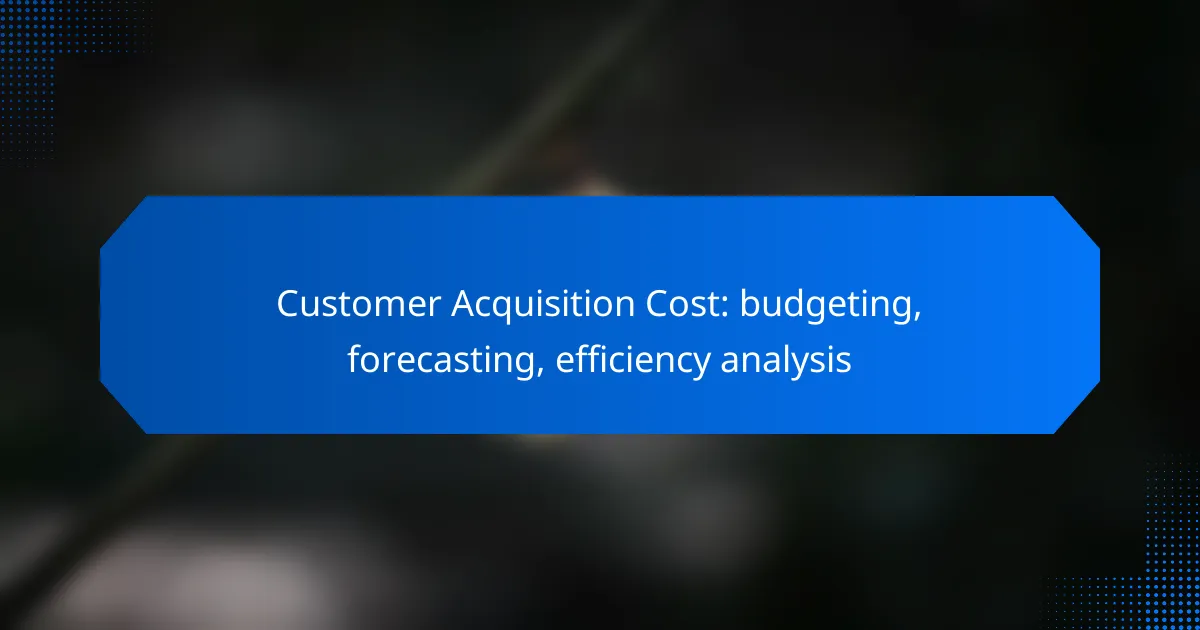
Understanding Customer Acquisition Cost (CAC) is crucial for businesses aiming to optimize their marketing and sales strategies. By calculating CAC, companies can assess the efficiency of their customer acquisition efforts and align their budgeting with revenue goals. Accurate forecasting and effective resource allocation further enhance profitability and ensure sustainable growth in a competitive market.
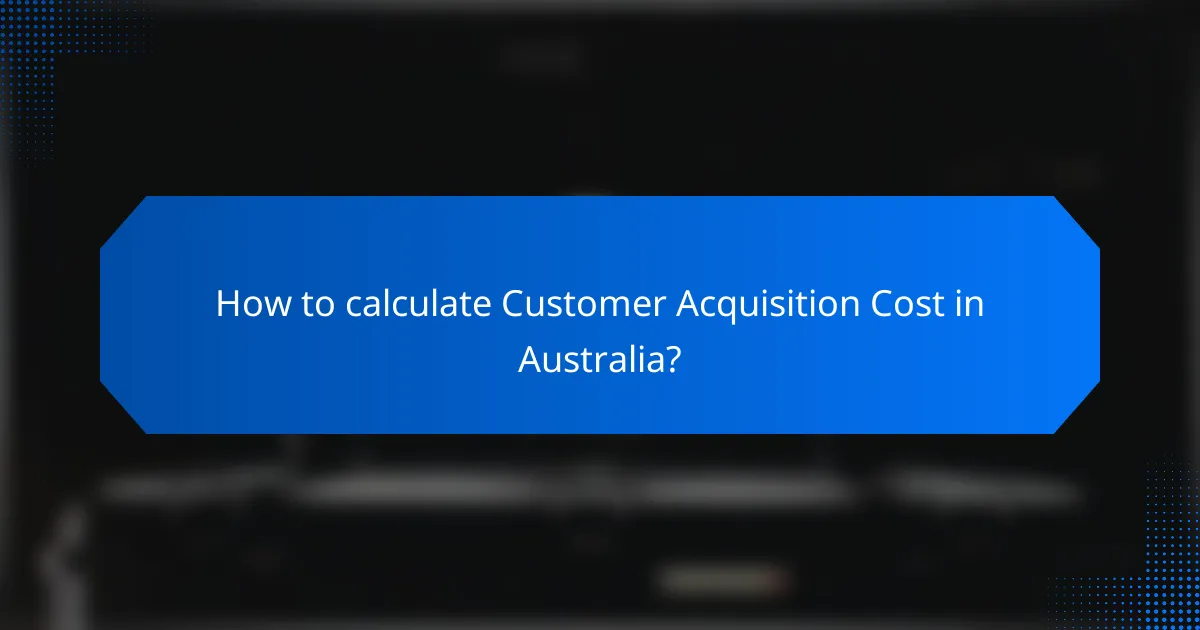
How to calculate Customer Acquisition Cost in Australia?
To calculate Customer Acquisition Cost (CAC) in Australia, divide the total expenses associated with acquiring new customers by the number of customers gained during a specific period. This metric helps businesses understand the efficiency of their marketing and sales efforts in the Australian market.
Formula for CAC
The formula for calculating CAC is straightforward: CAC = Total Acquisition Costs / Number of New Customers. Total acquisition costs include expenses such as marketing campaigns, sales team salaries, and any other related costs incurred during the acquisition process.
For example, if a company spends AUD 10,000 on marketing and gains 100 new customers, the CAC would be AUD 100. This metric allows businesses to assess whether their customer acquisition strategies are financially viable.
Factors affecting CAC
Additionally, customer demographics play a role; targeting high-value segments may require more investment upfront but could lead to higher lifetime value. Understanding these factors helps businesses optimize their acquisition strategies and reduce CAC over time.
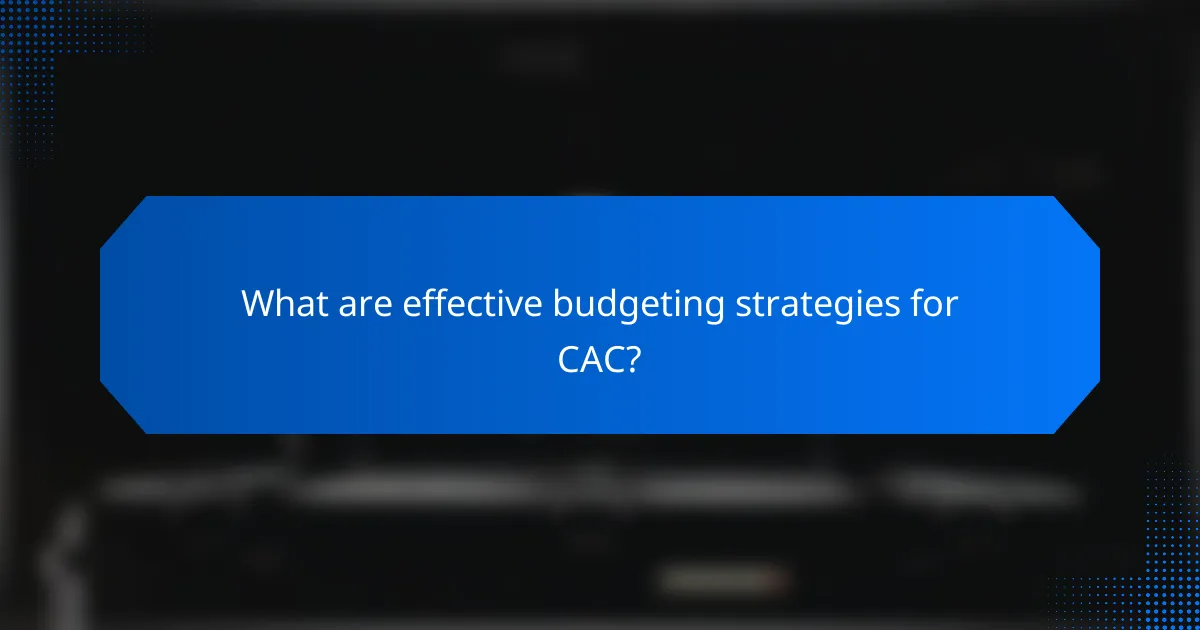
What are effective budgeting strategies for CAC?
Effective budgeting strategies for Customer Acquisition Cost (CAC) focus on aligning marketing expenses with revenue goals while ensuring efficient resource allocation. By implementing structured approaches, businesses can optimize their spending and improve overall profitability.
Zero-based budgeting
Zero-based budgeting (ZBB) requires every department to justify its budget from scratch for each new period. This method ensures that all expenses are aligned with current business objectives, making it easier to identify unnecessary costs that can inflate CAC. Each marketing initiative must demonstrate its value and contribution to customer acquisition.
To implement ZBB, start by analyzing past expenditures and assessing their effectiveness. Set clear performance metrics to evaluate each campaign’s success. This approach can lead to more strategic spending, but it may require significant time and effort to justify every expense.
Percentage of revenue method
The percentage of revenue method allocates a fixed percentage of total revenue to customer acquisition efforts. This strategy links marketing budgets directly to sales performance, which can help maintain a balanced approach during fluctuating revenue periods. Typically, businesses allocate anywhere from 5% to 20% of their revenue to CAC, depending on industry standards.
When using this method, regularly review revenue forecasts and adjust the budget accordingly. This ensures that marketing efforts remain sustainable and aligned with overall business growth. However, be cautious of over-reliance on this method, as it may lead to underfunding during slower sales periods, impacting customer acquisition efforts.

How to forecast Customer Acquisition Cost accurately?
Accurate forecasting of Customer Acquisition Cost (CAC) involves analyzing past performance and understanding market dynamics. This enables businesses to allocate budgets effectively and anticipate future expenses related to acquiring new customers.
Historical data analysis
Analyzing historical data is crucial for forecasting CAC. Start by collecting data on past marketing campaigns, sales conversions, and customer acquisition expenses. Look for trends in how much was spent to acquire customers over different periods.
Utilize metrics such as cost per lead and cost per conversion to identify patterns. For instance, if your CAC has consistently ranged between 20-30% of your total marketing budget, this can serve as a baseline for future projections.
Market trend assessment
Market trends significantly influence CAC forecasts. Keep an eye on industry benchmarks and competitor spending to understand where your business stands. For example, if competitors are increasing their marketing budgets, it may indicate a need for you to adjust your CAC expectations accordingly.
Additionally, consider external factors such as economic conditions and consumer behavior shifts. If the market is trending towards digital channels, reallocating resources to online marketing may help optimize your CAC. Regularly reviewing these trends will ensure your forecasts remain relevant and accurate.
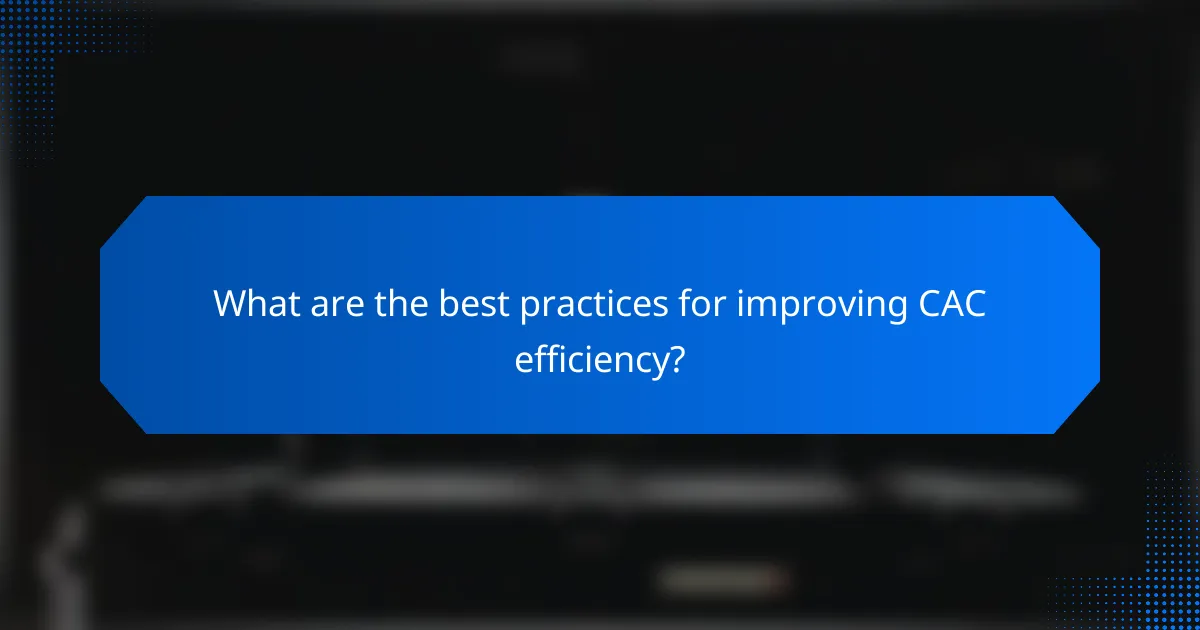
What are the best practices for improving CAC efficiency?
Improving Customer Acquisition Cost (CAC) efficiency involves strategic planning and execution in marketing and sales processes. By focusing on targeted advertising and optimizing sales funnels, businesses can significantly reduce CAC while increasing customer lifetime value.
Targeted advertising campaigns
Targeted advertising campaigns focus on reaching specific demographics or customer segments, which can enhance CAC efficiency. By utilizing data analytics and customer insights, businesses can tailor their messages to resonate with potential customers, leading to higher conversion rates.
Consider using platforms like Google Ads or Facebook Ads, which allow for detailed audience targeting based on interests, behaviors, and demographics. This approach can lead to a more efficient allocation of marketing budgets, often resulting in lower CAC compared to broader campaigns.
Optimizing sales funnels
Optimizing sales funnels involves streamlining the customer journey from awareness to purchase, which can significantly impact CAC. By identifying and addressing bottlenecks in the funnel, businesses can improve conversion rates and reduce the time and resources spent on acquiring customers.
Key steps include analyzing customer behavior at each stage of the funnel, implementing A/B testing for different strategies, and ensuring that follow-up processes are efficient. Regularly reviewing and refining these processes can lead to sustained improvements in CAC efficiency.

What tools can help analyze CAC?
Several tools can effectively analyze Customer Acquisition Cost (CAC), helping businesses optimize their marketing budgets and strategies. These tools provide insights into customer behavior, campaign performance, and overall marketing efficiency.
HubSpot Marketing Hub
HubSpot Marketing Hub offers a comprehensive suite of tools for tracking and analyzing CAC. It integrates various marketing channels, allowing businesses to monitor lead generation, conversion rates, and customer engagement in one platform. This holistic view helps identify which campaigns yield the best return on investment.
To effectively use HubSpot for CAC analysis, set up tracking for all marketing campaigns and regularly review the performance metrics. Focus on metrics like cost per lead and conversion rates to assess which strategies are most effective. HubSpot’s reporting features can help visualize this data for better decision-making.
Google Analytics
Google Analytics is a powerful tool for analyzing website traffic and user behavior, which can directly impact CAC. By setting up goals and tracking conversions, businesses can determine how much they spend to acquire each customer through different channels. This data is crucial for understanding the effectiveness of online marketing efforts.
To maximize the benefits of Google Analytics for CAC analysis, ensure proper goal tracking is established. Use UTM parameters to differentiate traffic sources and assess their performance. Regularly analyze the data to identify trends and adjust marketing strategies accordingly, focusing on channels that provide the lowest CAC.
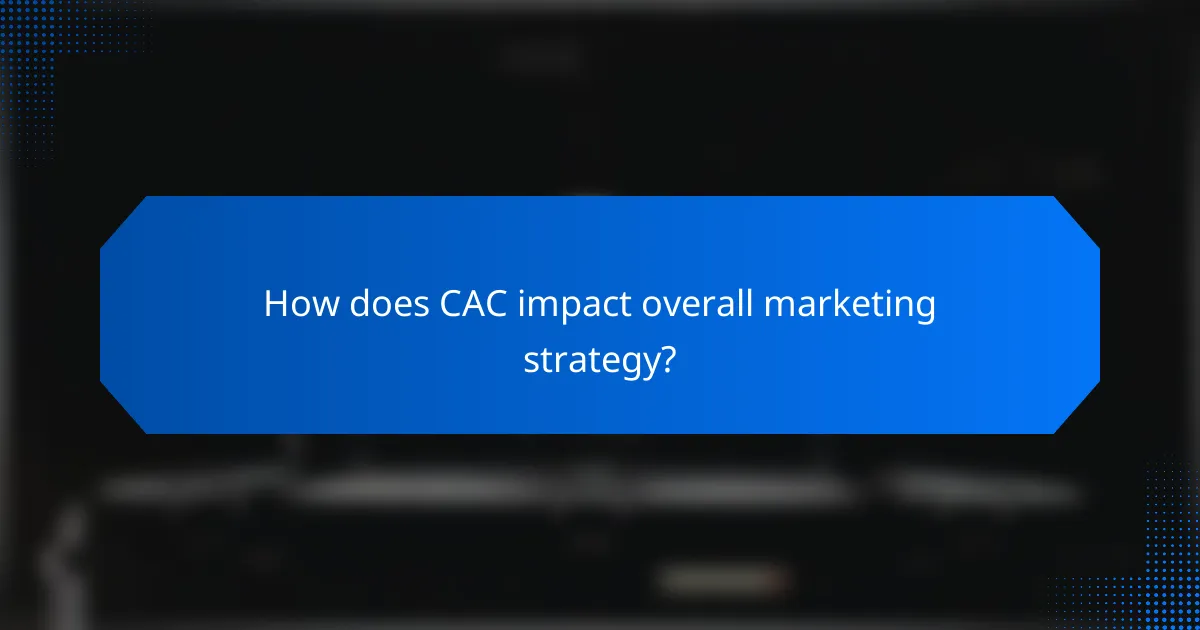
How does CAC impact overall marketing strategy?
Customer Acquisition Cost (CAC) significantly influences marketing strategy by determining how much a business can spend to gain new customers while remaining profitable. Understanding CAC helps in making informed decisions about budget allocation, campaign effectiveness, and overall marketing efficiency.
Budget allocation adjustments
Adjusting budget allocations based on CAC insights is crucial for optimizing marketing efforts. If CAC is high, it may indicate the need to reassess spending on specific channels or campaigns that are not delivering adequate returns. For example, if social media ads are yielding a CAC that exceeds the average customer lifetime value (CLV), reallocating funds to more effective channels, like email marketing, may be beneficial.
Consider implementing a flexible budgeting approach that allows for real-time adjustments based on CAC performance. Regularly reviewing CAC metrics can help identify trends and inform budget shifts, ensuring resources are directed towards the most efficient acquisition strategies.
Performance measurement
Measuring performance in relation to CAC is essential for evaluating the effectiveness of marketing strategies. Key performance indicators (KPIs) such as conversion rates, lead generation costs, and customer retention rates should be monitored alongside CAC to gain a comprehensive view of marketing success. This holistic approach enables businesses to identify which strategies yield the best results.
Utilize tools like dashboards to visualize CAC trends over time and compare them against marketing spend and revenue growth. This can help pinpoint successful campaigns and areas needing improvement. Regular performance reviews can prevent overspending and enhance overall marketing efficiency, ultimately leading to a more sustainable customer acquisition strategy.

What are common pitfalls in CAC analysis?
Common pitfalls in Customer Acquisition Cost (CAC) analysis include failing to account for long-term customer value and neglecting external factors that influence costs. These oversights can lead to inaccurate budgeting and forecasting, ultimately affecting business efficiency.
Ignoring long-term customer value
When analyzing CAC, it’s crucial to consider the long-term value of customers, often referred to as Customer Lifetime Value (CLV). Ignoring CLV can result in a skewed understanding of acquisition costs, as businesses may undervalue the profitability of customers who generate revenue over extended periods.
For instance, a business may spend significantly on acquiring a customer who initially appears costly but generates substantial revenue over several years. To avoid this pitfall, calculate CAC alongside CLV to ensure a balanced view of customer profitability.
Overlooking external factors
External factors such as market trends, economic conditions, and competitive landscape can significantly impact CAC. Failing to consider these elements may lead to unrealistic budgeting and forecasting, as acquisition costs can fluctuate based on these influences.
For example, during an economic downturn, customer acquisition may become more expensive due to increased competition and reduced consumer spending. Regularly review external factors and adjust your CAC analysis accordingly to maintain accuracy and relevance in your budgeting processes.

What emerging trends are shaping CAC in display advertising?
Emerging trends in display advertising are significantly influencing Customer Acquisition Cost (CAC) by shifting strategies towards more data-driven and personalized approaches. Advertisers are increasingly leveraging advanced analytics, automation, and artificial intelligence to optimize their campaigns and reduce costs.
Increased Use of AI and Automation
The integration of artificial intelligence and automation in display advertising is streamlining processes and enhancing targeting accuracy. AI algorithms analyze vast amounts of data to identify patterns and predict consumer behavior, allowing advertisers to tailor their messages effectively. This can lead to lower CAC as campaigns become more efficient and focused.
For instance, programmatic advertising utilizes AI to automate the buying and selling of ad space, which can significantly reduce costs compared to traditional methods. Advertisers can expect to see CAC decrease by targeting the right audience at the right time with minimal manual intervention.
Personalization and Targeting
Personalization is becoming a critical factor in display advertising, as consumers respond better to tailored messages. By utilizing data from various sources, advertisers can create highly targeted campaigns that resonate with specific demographics, interests, and behaviors. This targeted approach often results in higher conversion rates and lower CAC.
Advertisers should consider segmenting their audiences based on data insights and crafting personalized ad content. For example, a retailer might target ads for winter clothing to users who have previously shown interest in similar products, thereby improving engagement and reducing acquisition costs.
Focus on Cross-Channel Strategies
Cross-channel advertising strategies are gaining traction as brands seek to create a cohesive customer journey across multiple platforms. By integrating display advertising with social media, email, and other digital channels, advertisers can enhance visibility and engagement, ultimately lowering CAC.
To implement a successful cross-channel strategy, businesses should ensure consistent messaging and branding across all platforms. This approach not only strengthens brand recognition but also increases the likelihood of conversions, thereby optimizing CAC.
